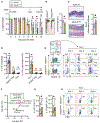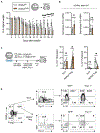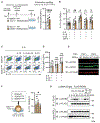RORγt phosphorylation protects against T cell-mediated inflammation
- PMID: 35294872
- PMCID: PMC8982147
- DOI: 10.1016/j.celrep.2022.110520
RORγt phosphorylation protects against T cell-mediated inflammation
Abstract
RAR-related orphan receptor-γ (RORγt) is an essential transcription factor for thymic T cell development, secondary lymphoid tissue organogenesis, and peripheral immune cell differentiation. Serine 182 phosphorylation is a major post-translational modification (PTM) on RORγt. However, the in vivo contribution of this PTM in health and disease settings is unclear. We report that this PTM is not involved in thymic T cell development and effector T cell differentiation. Instead, it is a critical regulator of inflammation downstream of IL-1β signaling and extracellular signal regulated kinases (ERKs) activation. ERKs phosphorylation of serine 182 on RORγt serves to simultaneously restrict Th17 hyperactivation and promote anti-inflammatory cytokine IL-10 production in RORγt+ Treg cells. Phospho-null RORγtS182A knockin mice experience exacerbated inflammation in models of colitis and experimental autoimmune encephalomyelitis (EAE). In summary, the IL-1β-ERK-RORγtS182 circuit protects against T cell-mediated inflammation and provides potential therapeutic targets to combat autoimmune diseases.
Keywords: EAE; ERK; IL-10; IL-17A; RORγt; RORγt(+) Tregs; Th17; colitis; inflammation; phosphorylation.
Copyright © 2022 The Authors. Published by Elsevier Inc. All rights reserved.
Conflict of interest statement
Declaration of interests B.S. has been a consultant to Ferring Research Institute, Gelesis, HOST Therabiomics, Intercept Pharmaceuticals, Mabwell Therapeutics, Patara Pharmaceuticals, and Takeda. The University of California, San Diego (B.S.’s institution) has received research support from Axial Biotherapeutics, BiomX, CymaBay Therapeutics, NGM Biopharmaceuticals, Prodigy Biotech, and Synlogic Operating Company. B.S. is the founder of Nterica Bio.
Figures







Similar articles
-
SRC1 promotes Th17 differentiation by overriding Foxp3 suppression to stimulate RORγt activity in a PKC-θ-dependent manner.Proc Natl Acad Sci U S A. 2018 Jan 16;115(3):E458-E467. doi: 10.1073/pnas.1717789115. Epub 2017 Dec 27. Proc Natl Acad Sci U S A. 2018. PMID: 29282318 Free PMC article.
-
Generation of RORγt+ Antigen-Specific T Regulatory 17 Cells from Foxp3+ Precursors in Autoimmunity.Cell Rep. 2017 Oct 3;21(1):195-207. doi: 10.1016/j.celrep.2017.09.021. Cell Rep. 2017. PMID: 28978473 Free PMC article.
-
STA-21, a small molecule STAT3 inhibitor, ameliorates experimental autoimmune encephalomyelitis by altering Th-17/Treg balance.Int Immunopharmacol. 2023 Jun;119:110160. doi: 10.1016/j.intimp.2023.110160. Epub 2023 Apr 18. Int Immunopharmacol. 2023. PMID: 37080068
-
Retinoid-Related Orphan Receptor RORγt in CD4+ T-Cell-Mediated Intestinal Homeostasis and Inflammation.Am J Pathol. 2020 Oct;190(10):1984-1999. doi: 10.1016/j.ajpath.2020.07.010. Epub 2020 Jul 29. Am J Pathol. 2020. PMID: 32735890 Review.
-
RORγt protein modifications and IL-17-mediated inflammation.Trends Immunol. 2021 Nov;42(11):1037-1050. doi: 10.1016/j.it.2021.09.005. Epub 2021 Oct 9. Trends Immunol. 2021. PMID: 34635393 Free PMC article. Review.
Cited by
-
Regulatory T cell therapy promotes TGF-β and IL-6-dependent pro-inflammatory Th17 cell generation by reducing IL-2.Nat Commun. 2025 Aug 16;16(1):7644. doi: 10.1038/s41467-025-62628-7. Nat Commun. 2025. PMID: 40818959 Free PMC article.
-
Identification of crosstalk genes relating to ECM-receptor interaction genes in MASH and DN using bioinformatics and machine learning.J Cell Mol Med. 2024 Mar;28(6):e18156. doi: 10.1111/jcmm.18156. J Cell Mol Med. 2024. PMID: 38429902 Free PMC article.
-
RNA binding protein DDX5 restricts RORγt+ Treg suppressor function to promote intestine inflammation.Sci Adv. 2023 Feb 3;9(5):eadd6165. doi: 10.1126/sciadv.add6165. Epub 2023 Feb 1. Sci Adv. 2023. PMID: 36724232 Free PMC article.
-
Mitogen-Activated Protein Kinase and Exploratory Nuclear Receptor Crosstalk in Cancer Immunotherapy.Int J Mol Sci. 2023 Sep 26;24(19):14546. doi: 10.3390/ijms241914546. Int J Mol Sci. 2023. PMID: 37833991 Free PMC article. Review.
-
ERK/MEK Pathway Regulates Th17 Cell Differentiation in Patients with Pemphigus Vulgaris.Indian J Dermatol. 2023 Nov-Dec;68(6):724. doi: 10.4103/ijd.ijd_924_22. Epub 2024 Jan 9. Indian J Dermatol. 2023. PMID: 38371571 Free PMC article.
References
-
- Abe Y, Fujiwara Y, Takahashi H, Matsumura Y, Sawada T, Jiang S, Nakaki R, Uchida A, Nagao N, Naito M, et al. (2018). Histone demethylase JMJD1A coordinates acute and chronic adaptation to cold stress via thermogenic phospho-switch. Nat. Commun 9, 1566. 10.1038/s41467-018-03868-8. - DOI - PMC - PubMed
MeSH terms
Substances
Grants and funding
LinkOut - more resources
Full Text Sources
Molecular Biology Databases
Research Materials
Miscellaneous

